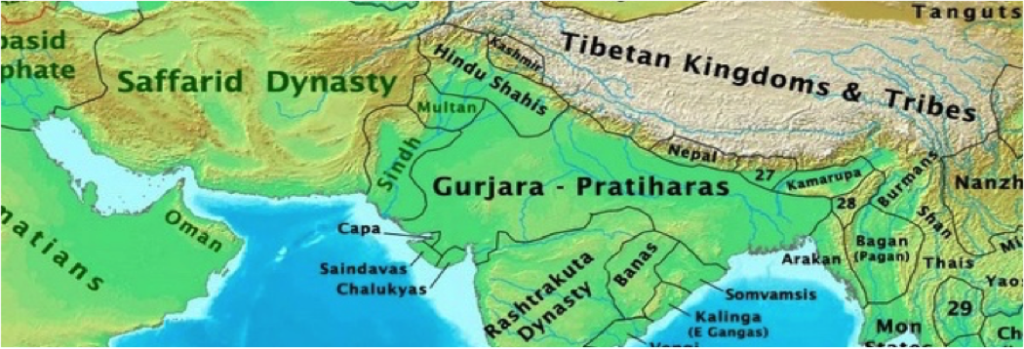Gurjara Kingdom
From 550 to 1018 AD, the Gurjars played a great part in history of Northern India nearly for 500 years. The Gurjara-Pratihara King Nagabhatt I won Kannuaj and established rule over most of Rajasthan. The capital of their Kingdom was shreemal, which is old name of Bhinmal in Jalore.

Administration of the Pratihara
In the Gurjara-Pratihara history, king occupied the highest position in the state and had enormous powers, kings adopted big titles such as ‘Parmeshwara’, ‘Maharajadhiraja’, ‘Parambhaterak’. The appointment of the samantas and singing on giants and charities were also the works of the kings. The samantas used to give military help to their Kings and fought for them the advice of the high officers was taken in matters of administration. However, there is no reference of mantriparishad or ministers in the inscriptions of that period. There are eight types of different officers in the administration of the Pratiharas such as Kottapala; highest officer of the fort, Tantrapala; representative 8 of the king in samanta states, Dandapashika was highest officer of the police, Dandanayaka look after the military and justice department, Dutaka carry order and grants of the king to specified persons, Bhangika was the officer who wrote order of charities and grants, Vynaharina was probably some legal expert and used to provide legal advice and finally Baladhikrat was the chief of army.
The entire state was divided into many bhuktis. There were many mandals in each bhukti and each mandala had several cities and many villages as well. Thus the Pratiharas had organized their empire into different units for administrative convenience. The samantas were called Maha samantahipati or Maha Pratihara. The villages were locally administered. The elders of the villages were called Mahattar who looked after the administration of the village. Gramapati was an officer of the state who advised in matters of village administration. The administration of the city was looked after by councils which are referred as Goshthi, Panchakula, Sanviyaka and Uttar sobha in the inscriptions of the Pratiharas. Thus the administration of the Pratiharas was quite efficient. It was on account of the efficient administration that the Pratiharas were able to defend India from the attacks of the Arabs.
Pratihara’s of Mandore
Mandore is an ancient town, and was the seat of the Pratiharas of Mandavyapura, who ruled the region in the 6th century CE. The origin of the dynasty is described in two inscriptions: the 837 CE Jodhpur inscription of Bauka and the 861 CE Ghantiyala (or Ghatiyala) inscription of Kakkuka.
Raja Harishchandra Pratihara is described as the founder of the clan. He had four sons: Bhogabhatta, Kakka, Rajjila and Dadda. Nagabhata, fourth in line from Harichandra, moved his capital from Mandavyapura to Medantaka (modern Merta).
Rudolf Hoernlé assumed a period of 20 years for each generation, and placed the dynasty’s founder Harichandra in c. 640 CE. Baij Nath Puri placed Harichandra in c. 600 CE. R. C. Majumdar, on the other hand, assumed a period of 25 years for each generation, and placed him in c. 550 CE. The following is a list of the dynasty’s rulers and estimates of their reigns, assuming a period of 25 years:
- Harichandra alias Rohilladhi (c. 550 CE)
- Rajilla (c. 575 CE)
- Narabhatta alias Pellapelli (c. 600 CE)
- Nagabhata alias Nahada (c. 625 CE)
- Tata and Bhoja (c. 650 CE)
- Yashovardhana (c. 675 CE)
- Chanduka (c. 700 CE)
- Shiluka alias Silluka (c. 725 CE)
- Jhota (c. 750 CE)
- Bhilladitya alias Bhilluka (c. 775 CE)
- Kakka (c. 800 CE)
- Bauka (c. 825 CE)
- Kakkuka (c. 861 CE)
After the disintegration of the Gurjara-Pratihara empire, one branch of Pratiharas continued to rule at Mandore. In 1395 CE, a princess of this branch married Rao Chunda of Rathore clan. As a result, Rao Chunda received the Junagarh fort in Mandore in dowry, and moved his capital to the site. The town remained the Rathore capital until 1459 CE, when Rao Jodha shifted his capital to the newly founded city of Jodhpur.

